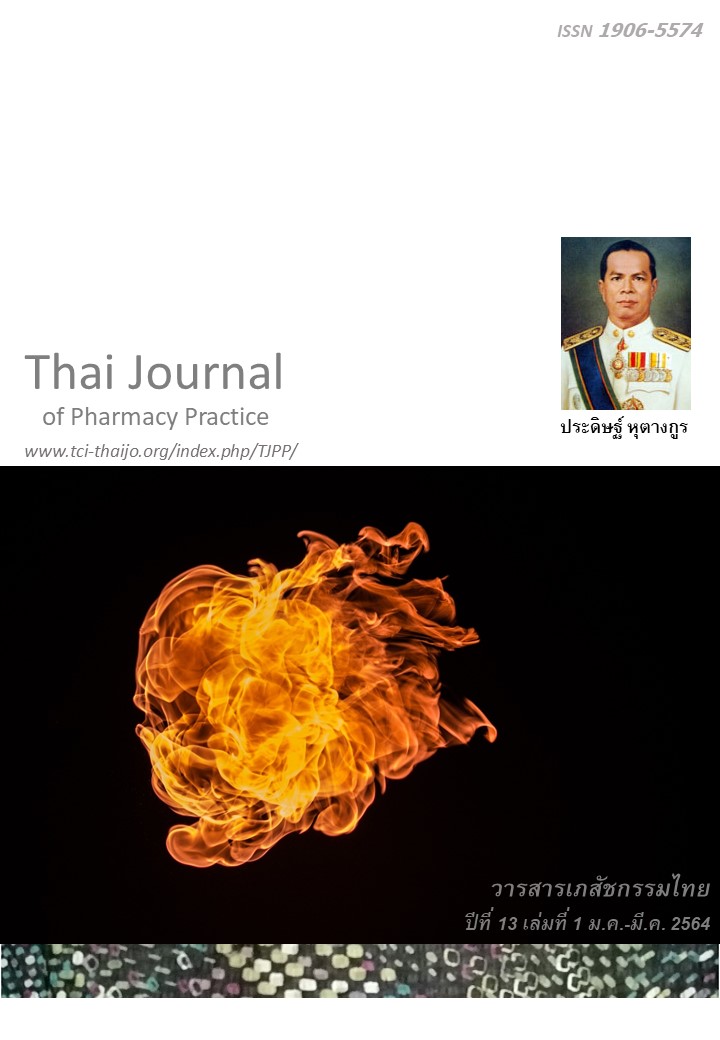อุบัติการณ์ของภาวะเลือดออกทางเดินอาหารในผู้ป่วยภาวะหัวใจขาดเลือดเฉียบพลันชาวไทยที่ ได้รับการบำบัดด้วยยาต้านเกล็ดเลือดสองชนิดร่วมกับยาลดการหลั่งกรดกลุ่มยับยั้งโปรตอนปั๊ม
Main Article Content
บทคัดย่อ
วัตถุประสงค์: เพื่อศึกษาอุบัติการณ์ของภาวะเลือดออกทางเดินอาหารในผู้ป่วยภาวะหัวใจขาดเลือดเฉียบพลันชาวไทยที่ได้รับการบำบัดด้วยยาต้านเกล็ดเลือดสองชนิด (dual antiplatelet therapy; DAPT) ร่วมกับยาลดการหลั่งกรดกลุ่มยับยั้งโปรตอนปั๊ม (proton pump inhibitors; PPIs) และประเมินความเหมาะสมของการใช้ยา PPIs วิธีการ: การวิจัยนี้เป็นการวิจัยเชิงพรรณนาโดยเก็บข้อมูลย้อนหลังในผู้ป่วยกลุ่มอาการหลอดเลือดหัวใจตีบเฉียบพลัน 738 รายที่ได้รับ DAPT ร่วมกับ PPIs ที่มารับการรักษา ณ สถาบันโรคทรวงอก ระหว่างเดือนมกราคม พ.ศ. 2559 - ธันวาคม พ.ศ. 2560 ผลลัพธ์หลักที่ศึกษา คือ ภาวะเลือดออกทางเดินอาหาร ผลการวิจัย: อุบัติการณ์เกิดภาวะเลือดออกในทางเดินอาหาร คือ ร้อยละ 1.49 เมื่อทบทวนความเหมาะสมของการให้ PPIs ร่วมกับ DAPT พบว่า ร้อยละ 54.61 ของผู้ป่วยอาจไม่จำเป็นต้องได้รับ PPIs ร่วมด้วย ผู้ป่วยที่มีข้อบ่งใช้ของ PPIs มีอุบัติการณ์เกิดเลือดออกในทางเดินอาหารร้อยละ 2.1 ขณะที่ผู้ป่วยที่อาจไม่จำเป็นต้องได้รับ PPIs มีอุบัติการณ์เกิดเลือดออกในทางเดินอาหารเพียงร้อยละ 1 สรุป: แม้ผู้ป่วยจะได้รับ DAPT ร่วมกับยากลุ่ม PPIs เพื่อป้องกันการเกิดเหตุการณ์ไม่พึงประสงค์ต่อทางเดินอาหาร อย่างไรก็ตามผู้ป่วยที่มีความเสี่ยงสูงและมีข้อบ่งใช้ของการได้รับยากลุ่ม PPIs ยังคงเกิดภาวะเลือดออกในทางเดินอาหารมากกว่าผู้ป่วยที่อาจไม่จำเป็นต้องได้รับยากลุ่ม PPIs ถึง 2 เท่า เภสัชกรควรให้ข้อมูลการใช้ยาอย่างถูกต้อง รวมถึงคำแนะนำในการปฏิบัติตนแก่ผู้ป่วยที่ได้รับการบำบัดด้วย DAPT เพื่อลดความเสี่ยงในการเกิดอาการไม่พึงประสงค์ต่อระบบทางเดินอาหาร โดยเฉพาะอย่างยิ่งภาวะเลือดออกในทางเดินอาหาร
Article Details
ผลการวิจัยและความคิดเห็นที่ปรากฏในบทความถือเป็นความคิดเห็นและอยู่ในความรับผิดชอบของผู้นิพนธ์ มิใช่ความเห็นหรือความรับผิดชอบของกองบรรณาธิการ หรือคณะเภสัชศาสตร์ มหาวิทยาลัยสงขลานครินทร์ ทั้งนี้ไม่รวมความผิดพลาดอันเกิดจากการพิมพ์ บทความที่ได้รับการเผยแพร่โดยวารสารเภสัชกรรมไทยถือเป็นสิทธิ์ของวารสารฯ
เอกสารอ้างอิง
Department of Disease Control. Global action plan for the prevention and control of NCDs 2016-2021. 2nd ed. Bangkok: Division of Non Communicable Diseases; 2016.
Phunmung N. World heart day message [online]. 2017 [cited Dec 12, 2018]. Available from: www.thai ncd.com/document/fle/info/non-communicable-dise ase/ประเด็นสารรณรงค์วันหัวใจโลกปี 2560.pdf
Sitthisuk S. Clinical practice guideline to caring patients with ischemic heart disease in Thailand 2014. 2nd ed. Bangkok: The Heart Association of Thailand; 2008.
Valgimigli M, Bueno H, Byrne RA, Collet JP, Costa F, Jeppsson A, et al. 2017 ESC focused update on dual antiplatelet therapy in coronary artery disease developed in collaboration with EACTS: The task force for dual antiplatelet therapy in coronary artery disease of the European Society of Cardiology (ESC) and of the European Association for Cardio-Thoracic Surgery (EACTS). Eur Heart J. 2018;39:213-60.
Amsterdam EA, Wenger NK, Brindis RG, Casey DE, Jr., Ganiats TG, Holmes DR, Jr., et al. 2014 AHA/ ACC guideline for the management of patients with non-ST-elevation acute coronary syndromes: a report of the American College of Cardiology/ American Heart Association Task Force on Practice Guidelines. Circulation. 2014;130: e344-426.
Roffi M, Patrono C, Collet J, Mueller C, Valgimigli M, Andreotti F, et al. Management of acute coronary syndromes in patients presenting without persistent STSEotESoC. 2015 ESC Guidelines for the management of acute coronary syndromes in patients presenting without persistent ST-segment elevation: Task force for the management of acute coronary syndromes in patients presenting without persistent ST-segment elevation of the European Society of Cardiology (ESC). Eur Heart J. 2016; 37: 267-315.
Bhatt DL, Cryer BL, Contant CF, Cohen M, Lanas A, Schnitzer TJ, et al. Clopidogrel with or without omeprazole in coronary artery disease. N Engl J Med. 2010;363:1909-17.
Hu W, Tong J, Kuang X, Chen W, Liu ZJM. Influence of proton pump inhibitors on clinical outcomes in coronary heart disease patients receiving aspirin and clopidogrel: A meta-analysis. Medicine. 2018;97: e9638. doi: 10.1097/MD.0000000000009 638.
Simon T, Verstuyft C, Mary-Krause M, Quteineh L, Drouet E, Méneveau N, et al. Genetic determinants of response to clopidogrel and cardiovascular events. N Engl J Med. 2009; 360: 363–75.
Collet J-P, Hulot J-S, Pena A, Villard E, Esteve J-B, Silvain J, et al. Cytochrome P450 2C19 polymor phism in young patients treated with clopidogrel after myocardial infarction: a cohort study. Lancet. 2009; 373: 309-17.
Ramirez JF, Selzer F, Chakaprani R, Anderson WD, Lee JS, Smith C, Mulukutla SR, Kip KE, Kelsey SF, Marroquin OC. Proton pump inhibitor and clopido grel combination is not associated with adverse clinical outcomes after PCI: the NHLBI dynamic registry. J Am Coll Cardiol 2009; 53 (Suppl 1): A27.
Uantyai N, Phromintikul A, Chinwong S and Niwata nanun K. Clinical outcomes of Thai patients with acute coronary syndrome receiving clopidogrel concomitant with omeprazole. Naresuan Phayao Journal. 2014;7:212-25.
Ho PM, Maddox TM, Wang L, Fihn SD, Jesse RL, Peterson ED, et al. Risk of adverse outcomes associated with concomitant use of clopidogrel and proton pump inhibitors following acute coronary syndrome. JAMA. 2009;301: 937-44.
Juurlink DN, Gomes T, Ko DT, Szmitko PE, Austin PC, Tu JV, et al. A population-based study of the drug interaction between proton pump inhibitors and clopidogrel. CMAJ. 2009;180: 713-8.
Society for Cardiovascular Angiography and Interventions. Statement on “A national study of the effect of individual proton pump inhibitors on cardiovascular outcomes in patients treated with clopidogrel following coronary stenting: The Clopido grel Medco Outcomes [online] 2009. [cited Dec 12, 2018]. Available from: www.scai.org/drlt1.aspx?PA GE_ ID=5870.
Chatrattanakulchai B, Hirunrassamee S, Kanchana phibool I. Antisecretory drug use for prophylaxis of upper gastrointestinal bleeding in patients receiving aspirin together with clopidogrel. Veridian E-Journal Science and Technology Silpakorn University. 2018 ; 5: 65-76.
Doungngern T, Ngorsuraches S. Efficacy and safety of proton pump inhibitors [online]. 2012 [cited Oct 10, 2018]. Available from: hisro.or.th/main/down load/book022.pdf.
Suchartlikitwong S, Lapumnuaypol K, Rerknimitr R, Werawatganon DJAB. Epidemiology of upper gas trointestinal bleeding and Helicobacter pylori infection: review of 3,488 Thai patients. Asian Biomed 2015; 9: 87-93.


